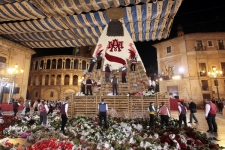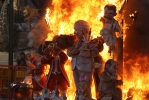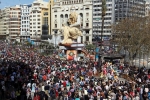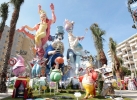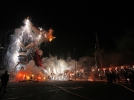Print
IDENTIFICATION | IDENTIFICACIÓN | IDENTIFICAÇÃO
Tangible or Intangible
Intantigle | Inmaterial | Imaterial
Image credits | Créditos de imagen | Créditos de imagem
Josep Zaragoza in Unesco ICH website
Title, name | Titulo, nombre | Título, nome
Valencia Fallas festivity / La fiesta de las Fallas valencianas
Short description | Descripción corta | Descrição resumida
The main feature of the Fallas Festivity, a tradition of communities in Valencia and its diaspora celebrating the coming of spring, is the giant falla. The falla is a monument made up of ninots (caricature pieces) created by local artists and craftspeople that provides a commentary on current social issues. Erected in the town square, the falla is set alight at the end of the festivity, which runs from March 14 to 19, to symbolize the coming of spring, purification and a rejuvenation of community social activity. In the meantime, marching bands parade the streets, outdoor meals are held and fireworks staged. Each year, a Fallas Queen is elected to promote the festivity throughout the year encouraging locals and visitors to take part. Know-how associated with the practice is transmitted within families, particularly those involved in the construction of the ninots who belong to different guilds among participating communities. The Fallas Festivity provides an opportunity for collective creativity and the safeguarding of traditional arts and crafts. It is also a source of community pride, contributor to cultural identity and enhances social cohesion. In the past, the festivity was also a way of preserving the Valencian language when it was prohibited.
Celebrada para saludar la llegada de la primavera por comunidades de la ciudad y región de Valencia y por la diáspora valenciana emigrada al extranjero, esta fiesta tradicional se caracteriza por la construcción e instalación de enormes grupos escultóricos (''fallas'') compuestos por efigies caricaturescas (''ninots''), que los artistas y artesanos locales crean inspirándose en sucesos de la actualidad política y social. Para simbolizar la purificación y renovación primaverales de la actividad social de las comunidades, las fallas se erigen en las plazas de la ciudad entre el 14 y el 19 de marzo y se les prende fuego este último día, que marca el fin de los festejos. Mientras dura la fiesta desfilan por las calles bandas de música, el público come al aire libre y se tiran numerosos castillos de fuegos artificiales. Se elige a una reina de la fiesta, la “Fallera Mayor”, que asume la tarea de promover la festividad durante un año, alentando a la población local y a los visitantes a contribuir a la preparación de los festejos y participar en ellos. Las prácticas y los conocimientos vinculados a este elemento del patrimonio cultural se transmiten en las familias, y en particular dentro de las dinastías de artistas y artesanos fabricantes de ''ninots'' que se agrupan en gremios constituidos en el seno de las comunidades ciudadanas participantes. Las Fallas de Valencia propician la creatividad colectiva y la salvaguardia de las artes y artesanías tradicionales. También constituyen un motivo de orgullo para las comunidades y contribuyen a forjar su identidad cultural y su cohesión social. En el pasado, esta fiesta permitió también que se preservara la lengua valenciana cuando se prohibió su uso.
Celebrada para saludar la llegada de la primavera por comunidades de la ciudad y región de Valencia y por la diáspora valenciana emigrada al extranjero, esta fiesta tradicional se caracteriza por la construcción e instalación de enormes grupos escultóricos (''fallas'') compuestos por efigies caricaturescas (''ninots''), que los artistas y artesanos locales crean inspirándose en sucesos de la actualidad política y social. Para simbolizar la purificación y renovación primaverales de la actividad social de las comunidades, las fallas se erigen en las plazas de la ciudad entre el 14 y el 19 de marzo y se les prende fuego este último día, que marca el fin de los festejos. Mientras dura la fiesta desfilan por las calles bandas de música, el público come al aire libre y se tiran numerosos castillos de fuegos artificiales. Se elige a una reina de la fiesta, la “Fallera Mayor”, que asume la tarea de promover la festividad durante un año, alentando a la población local y a los visitantes a contribuir a la preparación de los festejos y participar en ellos. Las prácticas y los conocimientos vinculados a este elemento del patrimonio cultural se transmiten en las familias, y en particular dentro de las dinastías de artistas y artesanos fabricantes de ''ninots'' que se agrupan en gremios constituidos en el seno de las comunidades ciudadanas participantes. Las Fallas de Valencia propician la creatividad colectiva y la salvaguardia de las artes y artesanías tradicionales. También constituyen un motivo de orgullo para las comunidades y contribuyen a forjar su identidad cultural y su cohesión social. En el pasado, esta fiesta permitió también que se preservara la lengua valenciana cuando se prohibió su uso.
Community or culture | Comunidad o cultura | Comunidade ou cultura
Valencian Communities
Practitioners, Autor | Practicantes, Autores | Praticantes, Autores
Citizens (FALLEROS and FALLERAS), ARTISAN GUILD OF FALLAS ARTISTS, MUSICIANS
Museum | Museo | Museu
Place | Local | Local
Valencia region.
Country | País
España
Language | Idioma
Valenciano, Español
MEDIA
Video | Vídeo
Video credits | Créditos de vídeo | Créditos vídeo
Adarve producciones for the Central Board of Fallas 2012; Director: Jorge M. Guarro; Script: Vicent Artur Moreno; See more in the vídeo credits (min 9:25)
Audio
Audio Credits | Créditos de Audio
3D object | Objeto 3D
3D Credits | Créditos 3D
Text | Texto
Text credits | Créditos del texto | Créditos do texto
Record date | Fecha de registro | Data do registo
2016-11-30
Image 1 credits | Créditos imagen 1 | Créditos da imagem 1
Josep Zaragoza in Unesco ICH website
Image 2 credits | Créditos imagen 2 | Créditos da imagem 2
Josep Zaragoza in Unesco ICH website
Image 3 credits | | Créditos da imagem 3Créditos imagen 3
Josep Zaragoza in Unesco ICH website
Image 4 credits | Créditos imagen 4 | Créditos da imagem 4
Josep Zaragoza in Unesco ICH website
MORE INFORMATION | MÁS INFORMACIÓN | MAIS INFORMAÇÃO
Origin, history | Origen, historia | Origem, história
Historically, the Fallas festivity preserved the Valencian language when it was frowned upon or even prohibited.
The Valencian FALLAS festivity from 14 to 19 March is a celebration of rituals and traditions involving the creation and the destruction by fire of a central element called the "falla" monument.
Fallas Commissions in each neighbourhood create a large-scale catafalque or "falla", around which rituals are performed: street parades with music bands or traditional instruments, flower offerings to the Patron Saint, outdoor culinary events for sharing food, mostly “paella”. Falleros dress in traditional costumes and stage fireworks and pyrotechnical activities. There are night-time gatherings in Fallas “houses [casals] for meals and entertainment.
The "falla" is an ephemeral construction built over a period of various months leading up to the festivity by Fallas artists and craftsmen (painters, sculptors and carpenters) and it is burned to ashes in a bonfire on the evening of St. Joseph's Day, March 19th, symbolising the coming of Spring.
Thanks to the continuity of these festive rituals, a series of traditional and cultural practices with which the Valencian people are identified have been safeguarded over the years.
The FALLAS festivity provides a source of collective creativity and its conservation ensures the continuity of traditional “falla” building skills (construction, painting, decoration, erection), answering a social need for a sense of identity, and upholding traditional arts and crafts (costume, hairstyling, adornment, processionary techniques, flower arrangement, etc.) that would otherwise disappear.
The “falla” monument itself has a satirical character allowing for social, cultural and moral criticism, giving rise to a particular kind of literature (llibrets) in the vernacular language that would otherwise find no outlet.
The cultural meaning of the incineration of the monument is a form of purification, Spring cleaning and social renewal. Caricature figurines called “ninots” included in the “falla” act as scapegoats or sacrificial lambs of Valencian society. Their destruction by fire symbolises the renewal of social life. This element acts as an identifier that helps Valencians to reinforce social cohesion, at home and wherever they settle as emigrants. It gives them a sense of identity of which they are proud.
The festivity itself propitiates communication amongst different age groups and genders. Children participate in significant ways bringing about early socialisation in the mechanisms of transmission of the Fallas ritual. The artistic "falla" monument propitiates communication and dialogue amongst citizens. Symbolically, the material strivings of a whole year (contributions in money) are wantonly reduced to ashes to celebrate the arrival of a new season, enhancing the social life of each neighbourhood.
The Valencian FALLAS festivity from 14 to 19 March is a celebration of rituals and traditions involving the creation and the destruction by fire of a central element called the "falla" monument.
Fallas Commissions in each neighbourhood create a large-scale catafalque or "falla", around which rituals are performed: street parades with music bands or traditional instruments, flower offerings to the Patron Saint, outdoor culinary events for sharing food, mostly “paella”. Falleros dress in traditional costumes and stage fireworks and pyrotechnical activities. There are night-time gatherings in Fallas “houses [casals] for meals and entertainment.
The "falla" is an ephemeral construction built over a period of various months leading up to the festivity by Fallas artists and craftsmen (painters, sculptors and carpenters) and it is burned to ashes in a bonfire on the evening of St. Joseph's Day, March 19th, symbolising the coming of Spring.
Thanks to the continuity of these festive rituals, a series of traditional and cultural practices with which the Valencian people are identified have been safeguarded over the years.
The FALLAS festivity provides a source of collective creativity and its conservation ensures the continuity of traditional “falla” building skills (construction, painting, decoration, erection), answering a social need for a sense of identity, and upholding traditional arts and crafts (costume, hairstyling, adornment, processionary techniques, flower arrangement, etc.) that would otherwise disappear.
The “falla” monument itself has a satirical character allowing for social, cultural and moral criticism, giving rise to a particular kind of literature (llibrets) in the vernacular language that would otherwise find no outlet.
The cultural meaning of the incineration of the monument is a form of purification, Spring cleaning and social renewal. Caricature figurines called “ninots” included in the “falla” act as scapegoats or sacrificial lambs of Valencian society. Their destruction by fire symbolises the renewal of social life. This element acts as an identifier that helps Valencians to reinforce social cohesion, at home and wherever they settle as emigrants. It gives them a sense of identity of which they are proud.
The festivity itself propitiates communication amongst different age groups and genders. Children participate in significant ways bringing about early socialisation in the mechanisms of transmission of the Fallas ritual. The artistic "falla" monument propitiates communication and dialogue amongst citizens. Symbolically, the material strivings of a whole year (contributions in money) are wantonly reduced to ashes to celebrate the arrival of a new season, enhancing the social life of each neighbourhood.
Associated heritage | Patrimonio asociado | Património associado
Cross reference | Referencias cruzadas | Referências cruzadas
Present condition | Condición actual | Estado actual
The knowledge and skills related to organising the festivity and all social relations are transmitted by:
Fallas Commissions, where the family has a major role, with the participation of members of various generations (grandparents, parents and children), as well as friends and neighbours, propitiating intergenerational encounters and intergenerational transmission of traditions. Falleros and Falleras are taught from childhood to use the traditional elements of fire and fireworks properly. They are also taught the values of equality and respect for participants in the ritual, adapted to the requirements of an evolving society while preserving traditions; and respect for norms related to peaceful coexistence, sharing, sustainability and safety.
The knowledge and skills related to the creation and building of “falla” monuments are transmitted by Fallas Artists, or craftsmen and professionals, from generation to generation, through masters to apprentices. Recently, Higher Vocational Training programmes have been implemented within the school system, and Training Workshops are available for the various handcrafts related to this festivity. This includes standards for using and occupying public urban spaces with festival monuments.
The knowledge related to the making and use of traditional festive costumes and clothing and traditional hairstyling and arrangement of accessories forming part of the Fallera aesthetics are inherited from past generations and modernised by research from specialists. This includes special fabrics, embroidered silks in various colours and patterns, propitiating the preservation of ancient manual looms for their elaboration.
Fallas Commissions, where the family has a major role, with the participation of members of various generations (grandparents, parents and children), as well as friends and neighbours, propitiating intergenerational encounters and intergenerational transmission of traditions. Falleros and Falleras are taught from childhood to use the traditional elements of fire and fireworks properly. They are also taught the values of equality and respect for participants in the ritual, adapted to the requirements of an evolving society while preserving traditions; and respect for norms related to peaceful coexistence, sharing, sustainability and safety.
The knowledge and skills related to the creation and building of “falla” monuments are transmitted by Fallas Artists, or craftsmen and professionals, from generation to generation, through masters to apprentices. Recently, Higher Vocational Training programmes have been implemented within the school system, and Training Workshops are available for the various handcrafts related to this festivity. This includes standards for using and occupying public urban spaces with festival monuments.
The knowledge related to the making and use of traditional festive costumes and clothing and traditional hairstyling and arrangement of accessories forming part of the Fallera aesthetics are inherited from past generations and modernised by research from specialists. This includes special fabrics, embroidered silks in various colours and patterns, propitiating the preservation of ancient manual looms for their elaboration.
Threats | Amenazas | Ameaças
Safeguard | Salguardia | Salvaguarda
Bibliography | Bibliografía | Bibliografia
Source | Fuente | Fonte
TANGIBLE | MATERIAL
Type of object | Tipo de objeto | Tipo de objecto
Domain | Dominio | Domínio
Please select
Category | Categorías | Categoria
Please select | Seleccionar
Materials & techniques | Materiales y técnicas | Materiais & Tecnicas
Measurements | Medidas
Aditional info | Información adicional | Informação adicional
INTANGIBLE | INMATERIAL | IMATERIAL
Domain | Dominio | Dominío
Social practices rituals and festive events | Prácticas sociales y eventos festivos | Práticas sociais e celebrações
Category | Categoria
Cyclical festivities | Fiestas cíclicas | Festividades cíclicas, Collective Rituals | Rituales colectivos | Rituais colectivos, Recreational activities | Actividades lúdicas | Actividades lúdicas, Artistic and correlated manifestations | Espectáculo y entretenimiento | Manifestações artísticas e correlacionadas, Musical and Correlated Manifestations | Manifestaciones musicales y correlacionadas | Manifestações musicais e correlacionadas
Periodicity | Periodicidad | Periodicidade
annual, 14 to 19 March
Transmission | Trasmisión | Transmissão

